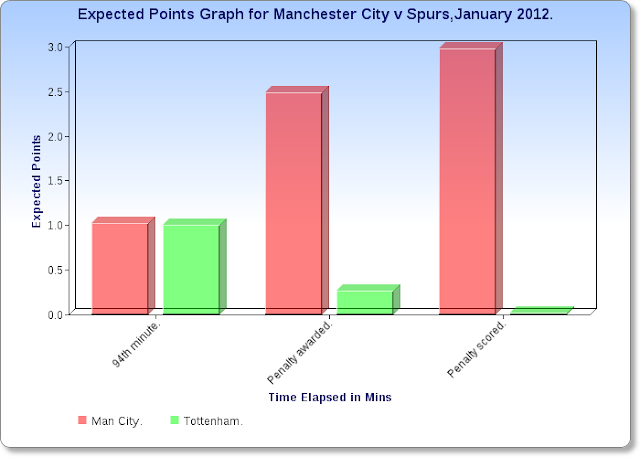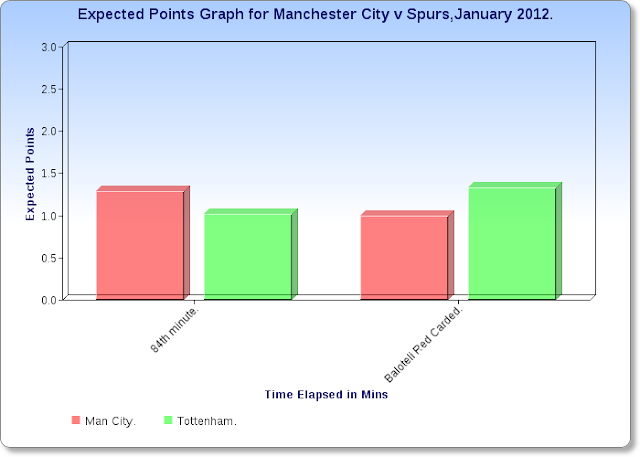We discussed and quantified home advantage in the EPL here and suggested a partial contributor to the effect here,in this post we'll try to use some of the more granular stats that are being made available and match these numbers to some of the more innovative research that has been done in the field.
Many factors have been proposed as playing a role in setting home field and whilst some have been discounted,others certainly play a partial role.Travel effects have in all probability declined with the improved transport network and over night stays becoming the norm.Crowd influence is probably an overstated factor.A research paper indicating that referees give different decisions when shown footballing incidents with the absence and presence of crowd noise was conducted with amateur refs from Staffordshire.From personal experience,not the most reliable of control groups.Familiarity with the playing surface is also probably less of a factor in football where there is little scope for improvisation in the presentation of the pitch.Very few professional grounds have the pronounced slopes that were part of the folk lore of giant killers such as Yeovil.Derby have long since departed from their quagmire at the Baseball Ground and present day Stoke with their narrow Highburyesque pitch are the closest you'll find to a team/pitch combination tailored to the needs of the hosts.
A more novel approach to home advantage appeared in the early 2000's when researches found an increased level of natural testosterone in both soccer and ice hockey players prior to home games compared to away contests and none competitive games.These increased levels in theory could lead to elevated aggression,better endurance and reaction time and additionally an enhancement of the passive aggressive effect postulated by evolutionary biologists when "trespassers" meet adversaries on none neutral ground.
Is seems reasonable to assume that if this phenomena is widespread in professional sport it will show up in the results of the many dozens of individual battles that occur during the duration of a team sport.Opta via it's resellers such as EPLIndex and the Guardian Chalkboards are gradually making more detailed statistics available and although the integrity and accuracy of these numbers is inevitably going to be slightly suspect through different interpretations of similar events by different data collectors,coupled with the mammoth task of maintaining massive databases it does open up new lines for investigation.
The success rates for individual tackles and the results of individual duels between players could be the kind of footballing incidents that are effected by the venue specific swings in both testosterone levels and heightened aggression.Therefore,I recorded how successful teams were in individual game incidents when they instigated tackles or duels at home and then on the road.
I chose the 2008/09 season at random and plotted how the percentage success rates for the cumulative individual totals for all 20 teams from that season changed for home and away games.Before we look at the graphs it's worth noting that one season is not sufficient to fully capture even such a fundamental feature as home advantage beyond doubt.The overall home and away trend should be evident,but there will be random outliers due to the relatively small sample size and so we should expect similar variation when looking at tackle or duelling events.
How a Team's Success Rate in Ground Duels Varied by Venue in 2008/09.
The best correlation from the three categories of on field,individual challenges that I looked at was for one player taking on an opponent on the ground.It's hard to imagine a contest more suited to demonstrating the presence of an elevated state of endurance,aggression and reaction time than this type of challenge.If the testosterone study has validity we are likely to see accumulated team success rates in these type of situations generally decline on the road and on the limited evidence of one EPL season that is what appears to happen.Based on the regression line,a team which wins 50% of these type of challenges at home would likely win just over 49% of them on the road.
 |
| A Naturally Aggressive Home Player Wins this Ground Duel with two Passive Away Opponents. |
How a Team's Success Rate in Aerial Duels Varied by Venue in 2008/09.
A similarly strong correlation exists for aerial battles.For much the majority of the line of best fit where the bulk of the points lie,teams win a higher proportion of aerial battles at home than they do away from their home stadium.The situation is briefly reversed when we look at the few very worst of performers,this may be a quirk of less robust sides or it may disappear in larger sized samples.
How a Team's Success Rate in Tackles Made Varied by Venue in 2008/09.
Possibly the most interesting set of results comes from the success rates of tackles made on opponents.There seems at first glance no reason why the percentage of successful tackles made by teams should not also benefit from the increased testosterone fuelled,none passive approach that prevails at home.Yet we see the reverse for almost half of the trendline.Teams actually appear to complete a higher proportion of tackles away from home than they do at home at lower completion rates.However,a team making 78% of successful tackles at home are only predicted to complete 76% on their travels which is more in keeping with the trends seen in duels.
A clue may be found in Opta's definition of a tackle.A tackle is deemed a success if it is played out of play and is "safe".If home teams are leading as they more often are at home,particularly late in the game they are also quite happy to see the ball out of play and safe,especially as they still retain possess from the throw or kick.This allows the away side to notch up artificially higher tackle counts with the complicit agreement of the home side.There's not quite the same level of guaranteed benefit to the (leading) home side in allowing the visitors to win a ground or air duel.Tackles are like shots on goal much more hostages to game context and a rich subject for further,more detailed investigation.
So far we've shown that duels if not tackles are won more often by the naturally pumped home side,but before we can reasonably conclude that these numerous individual pitch battles accumulate and contribute to home advantage we need to see if ground or aerial success rates are correlated to overall team success rate in games played.
How a Team's Seasonal Success Rate in Matches Correlates to it's Seasonal Success Rate in Ground Duels.
As before the trend and direction of the line of best fit is of more interest than the relatively weak,sample size driven correlation.The results are pooled from both home and away matches this time because we are simply interested in if winning a higher proportion of your ground duels enhances your chances of winning the game.And the upward direction of the slope indicates that this appears to be the case.A similar graph results from the data for aerial duels.
So to conclude.Various limited studies seem to indicate that home teams have elevated,naturally occurring testosterone levels compared to when they are the visitors and evolutionary biology suggests that species have evolved to act more aggressively when on their own turf.These two interconnected facts appear to be confirmed by home teams winning higher proportions of individual duels during matches and winning more of these duels correlates with winning matches.And this may go part of the way to explaining the universal occurrence of home field advantage in football.
Thanks to EPLIndex for access to the stats used here.
















